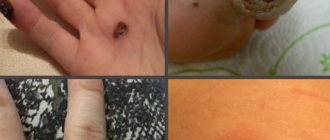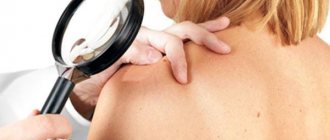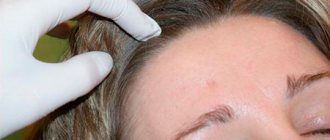Information about laser removal of warts and papillomas
Removing warts and papillomas with a laser is the fastest and most effective way. But not all doctors, much less patients, know the specifics of removal.
Depending on the type of laser, they can be used to treat many skin conditions.
What it is?
Laser radiation is a powerful energy light flux that causes a sharp increase in temperature in human tissues (evaporation). Due to its high power, lasers have become widely used in medicine over the past 30 years.
The following types of lasers are used in dermatovenerology:
Lasers with constant radiation (conventional)
They are used to remove warts, papillomas, genital warts, and molluscum contagiosum. They have powerful, highly focused constant radiation, which quickly leads to the evaporation of skin cells and pathological papillomas cells.
BUT: after such exposure, scars may remain on the skin. The principle is this: the larger the papillomas or wart, the larger the scar will remain on the skin after laser removal. It is not advisable to use such lasers on the face, as a clearly visible scar may remain (see photo below).
Pulsed lasers, or fractional lasers, or resurfacing lasers
In such devices, the laser beam does not act continuously, but in pulses (photo below). At the same time, the beam focusing is not so high, so there is no skin burn. When such a beam works, only the superficial layer of skin is removed in one pass. And subsequently there is no scar formation on the skin.
They are used for resurfacing (peeling) the facial skin, as well as for removing small senile keratomas and age spots, small papillomas and flat warts on the face.
Advantages of laser
- no bleeding
- no blisters on the skin
- scars are small or absent
- The procedure is quick – 5-7 minutes
- papillomas are removed in one session
Contraindications
- Inflammation of the skin at the treatment site
- Increased blood pressure before the procedure
- Cancer of any location
- ARVI and any increase in temperature
- Herpes on the skin
The procedure for removing a wart or papilloma with a laser
1) The doctor treats the skin with an antiseptic.
2) The doctor numbs the skin with an anesthetic (Novocaine, lidocaine or others). Anesthesia is carried out either by injection with a syringe, or by lubricating the skin with an anesthetic cream. It is advisable for a child (and an adult too) to take an insulin syringe so that he does not feel the injection.
3) It takes 3-5 minutes for the pain relief to take effect.
4) The doctor puts protective glasses on himself and the patient so that the laser beam does not burn the retina.
5) The doctor turns on the laser and treats the papilloma over its entire surface.
6) After treatment, a small wound remains - a burn. It is treated with fucorcin or another antiseptic. You can apply a dry gauze pad and a bandage on top.
Video on the topic of the material
What to choose?
- For spines on the hands and plantar warts on the feet: a regular laser with constant radiation. Read the article about thorns.
- For filiform papillomas and genital warts - also a regular laser. Read the article about filamentous warts.
- For flat warts, when papillomas are localized on the face, on the neck - a pulsed laser with a soft grinding effect. Read more about flat warts.
- When localizing genital warts in the vagina and cervix, a regular laser is also used. Read material about genital warts
What to do after removal? How to process it, how to care for it?
Wound care after laser wart removal:
- Do not get wet for 24 hours, do not swim. The next day a crust will begin to form.
- Do not remove the crust.
- Do not apply any creams or ointments.
- Don't sunbathe.
- Do not take a steam bath or swim in the pool.
- Do not wear cosmetics.
- You can lubricate it once a day with fucorcin or potassium permanganate.
- You can put a gauze napkin on the wound, and an adhesive plaster on top, crosswise.
- You can wash your hands (if there is a wound on your hand), but you cannot soak the scab for a long time.
- After 2-3 weeks the crust will come off on its own. And in its place there will be healthy skin.
What is better – laser or nitrogen removal of warts?
Doctor's advice: definitely - laser. Especially on delicate skin: on the neck, face, intimate places, etc.
According to reviews from doctors and patients, recurrences of warts after laser removal are 5 times less than after removal with nitrogen. Another thing is that the cost of laser removal is higher than that of nitrogen. I advise you to read the article about liquid nitrogen.
Laser removal of papillomas - prices in Moscow and regions?
Prices for laser removal of warts and papillomas depend on the type and location of the papilloma, the size, as well as the type of laser and the city (more expensive in Moscow):
- filiform papilloma, acrochord - 300 rubles
- small wart - 500 rubles
- papilloma, wart, large spine - 1000-2000 rubles (depending on complexity)
Find out the exact prices in clinics: go to Moscow and the regions.
In other cities the cost is 20-30% lower. That is, for example, in Chelyabinsk or Nizhny Novgorod, thread-like papillomas will be removed with a laser for 200 rubles, and a large plantar wart will be removed for 700-1000 rubles.
The final price is always announced by the doctor.
Photos before and after
1) Laser removal of a spine on the hand.
2) Laser removal of papillomas on the face.
3) Laser removal of papillomas on the neck.
During pregnancy
Can. But with a caveat: if you use a laser to remove papillomas and genital warts in intimate places. That is, where they will pose a danger to the child during childbirth.
In other parts of the body, you can wait until childbirth.
Consequences:
- Relapse – occurs due to incomplete treatment of the skin with a laser beam when papilloma cells remain.
- A scar on the skin is formed due to excessively deep treatment of the skin with a laser beam.
- Keloid scar is formed due to the individual characteristics of the patient’s skin.
I also recommend reading these materials:
Attention: if the doctor did not answer your question, then the answer is already on the pages of the site. Use the search on the site.
Sources used: www.dermatologvenerolog.ru
Causes and symptoms
The main cause of warts is the papilloma virus . Almost every person is infected with it, but it does not always manifest itself in the form of formations on the skin.
The presence of the virus may not be accompanied by severe symptoms. If a person has additional factors that contribute to the development of infection, then numerous signs appear, including warts.
The reasons for the appearance of warts include the following factors:
- contact with an infected person (personal or sexual);
- use of shared hygiene items or utensils;
- visiting public places (baths, saunas, swimming pools, etc.) where an infected person was;
- weakened state of the body (under the influence of stress, weak immunity, lack of sleep, etc.);
- disruption of the internal systems of the body under the influence of poor nutrition or bad habits.
A year after removal, the warts returned again, is it possible to remove them with Celandine?
Question
(Mikhail, 55 years old, wart recurrence)
Hello! My name is Mikhail, I'm 55. I have a problem with warts. I can’t understand whether it has completely disappeared or not. How to understand this? About a year ago I had a wart cut out on my foot in a clinic. A few months later it grew again in the same place, I didn’t go to the doctor right away, and later 3 more small ones grew next to the big one. I started using Celandine a month ago, two very small warts have already fallen off, but I’m very worried about the biggest one - I can see a black dot in the hole, is this the root? What to do next? Is it possible to continue dripping celandine into this hole from the excised wart?
A dermatologist answers your questions:
Yakubovskaya Svetlana Sergeevna
Graduated from Vitebsk State Medical University in 2008. Retraining in dermatovenerology since 2014.
Expert answer:
Hello, Mikhail! In your case, after they cut out a wart on your foot, a relapse occurred, which happens quite often, since the wart appeared again in the same place and there are also new ones nearby. Often these, so to speak, main or first, main growths are also called “maternal”. They are more difficult to remove than others because they are larger. In addition, plantar warts themselves are not removed with external preparations as quickly and easily as those on the hands.
If we assume that that black dot is a crust from a burn with a chemical preparation (in your case it is Celandine), then it would probably have disappeared within a month, besides, the entire surface of the growth should have been covered with such a black crust (within, as a rule, , 7 days) and disappear. In your case, I would certainly like to see a dermatologist in person for an examination. Perhaps the doctor will suggest that you remove it with liquid nitrogen, which, by the way, is much less likely to cause them to reoccur. Or, if you do not have any discomfort in this area, especially in the form of pain and burning, then you can try to carefully apply this drug again, having first protected the skin around it with a thick layer of Zinc ointment.
You can also ask your question
Answers to other questions can be read in the section
Sources used:bolezni-kozhi.ru
Causes and symptoms
The main cause of warts is the papilloma virus . Almost every person is infected with it, but it does not always manifest itself in the form of formations on the skin.
The presence of the virus may not be accompanied by severe symptoms. If a person has additional factors that contribute to the development of infection, then numerous signs appear, including warts.
- contact with an infected person (personal or sexual);
- use of shared hygiene items or utensils;
- visiting public places (baths, saunas, swimming pools, etc.) where an infected person was;
- weakened state of the body (under the influence of stress, weak immunity, lack of sleep, etc.);
- disruption of the internal systems of the body under the influence of poor nutrition or bad habits.
Why do papillomas appear again?
In the article you will learn why papillomas appear again, what to do with them and how to stop their appearance.
Being a piece of DNA in a protein shell, the virus can exist exclusively in a living cell. Once inside, the intracellular parasite tries to penetrate the DNA. However, if detected in a timely manner by antibodies, the viruses are absorbed by microphages and broken down. A malfunction in the body or its reduced immunity leads to the activation of the virus, resulting in the appearance of papillomas, warts, and condylomas.
Ways of infection with the virus
The appearance of human papillomavirus is possible:
- contact method (handshake, general hygiene products, clothing, underwear; visiting saunas, baths). Infection in this case is possible when the barrier function of the skin is impaired due to wounds, scratches, abrasions;
- vertical – the virus is transmitted to the child from the mother during childbirth, infection of the fetus in the womb is possible;
- sexually – the virus is transmitted during sexual intercourse, as well as anal and oral sex, not only from a partner with symptoms of the virus, but also from a virus carrier in the presence of microtraumas of the mucous membrane.
Weakened immunity leads to virus activity due to constant stress, lack of sleep, hypothermia, physical inactivity, long-term use of medications, as well as the presence of infectious foci in the body (sinusitis, caries, tonsillitis, dysbacteriosis, etc.)
Papillomas and warts
Under the influence of the virus, warts or papillomas appear on the human body. Both warts and papillomas are benign, have the same pathogen and are transmitted in identical ways. However, there are differences between them:
- papillomas are a soft formation with torn edges and a rough surface, located on a stalk filled with vessels through which nutrients are supplied to it. Warts are always dense and dry. Blood vessels do not fit into it and it fuses with the skin;
- papillomas affect bridges with high humidity (skin folds, armpits, groin, etc.). Warts – can be observed anywhere, but are most often observed on the hands and soles of the feet;
- Warts are usually flesh-colored, but can be lighter or darker than the skin. Papillomas come in light and dark shades;
- warts can disappear completely unexpectedly, papillomas disappear only after treatment;
- warts do not cause harm to health, even if they increase in size. If papillomas begin to grow, it is necessary to consult a doctor and have them removed;
- You can remove warts yourself; removal of papillomas is recommended only with the help of a specialist.
To diagnose the virus, specialists use polymerase chain reaction (PCR), DNA diagnostics, biopsy, and colposcopic examination.
Getting rid of papillomas
Modern medicine does not have the means to get rid of the human papillomavirus forever. Therefore, removing papillomas by any of the available methods does not provide a 100% guarantee of getting rid of the appearance of new formations. If papilloma appears, you can get rid of it in the following ways:
- The use of medications , with the help of which not only the formations are removed, but also the activity of the virus is suppressed, immunity is increased. Medicines help get rid of small growths that are light in color and located in areas with thin skin. The most popular of them are: “Ferezol”, “Dermavit”, “Superchistotel”, “Isoprinosine”. To prevent papillomas from appearing again, the doctor may prescribe antiviral immunostimulating drugs and immunomodulator drugs both during and after treatment.
- A surgical intervention during which papillomas are removed using a scalpel under local anesthesia. Next, a special bandage is applied. Removal by this method leads to bleeding and the formation of scars and unaesthetic scars. After surgical treatment, new formations may appear.
- Electrocoagulation is characterized by cauterization of the papilloma with a high-frequency electric current, which leads to coagulation (irreversible coagulation) of the protein tissue of the formation. Rarely causes bleeding or infection, but leaves scars. Local anesthesia may be used. Since electrocoagulation does not completely remove the growth, but only cauterizes it, new papillomas may appear.
- Cryotherapy , during which liquid nitrogen is used and the growth is frozen. The procedure takes place using a special applicator, previously immersed in liquid nitrogen. The specialist applies it to the papilloma, as a result of which the papilloma becomes dark, dries out and is torn away from the skin. With deep exposure, cryotherapy can cause burns and scar formation, otherwise there is a risk of incomplete removal of the tumor. No anesthesia is required, because no pain occurs.
- Using radio wave surgery, papilloma is eliminated with minimal impact on surrounding tissue. During the procedure, a “radio knife” is used and the electric current is converted into radio waves, with the help of which the formations are removed.
- Papillomas can be removed with a laser . At the moment, this is the most popular and in demand method. The surgical laser leads to evaporation of the growth, at the same time, “sealing” of the injured vessels and epithelial cells occurs. The risk of bleeding, inflammation and scarring is minimized. Specialists use local anesthesia, the skin heals within a week.
- You can remove papillomas using traditional methods . Celandine, banana peel, wormwood, thyme, walnut, onion and others have good effects. However, if a wart appears, they help eliminate the formation, but do not fight the virus.
The use of “grandmother’s methods”: ligation of the leg of the papilloma, spells and rituals, as well as independent elimination of the formation, is fraught with its degeneration into a cancerous disease. And also the occurrence of an inflammatory process and the spread of growths to healthy areas of the skin. The appearance of neoplasms is also characteristic of a number of other non-viral diseases. Diagnosis and treatment should be carried out exclusively by a specialist.
Time after papilloma removal
To prevent papillomas from appearing again, as well as to avoid inflammatory processes, it is necessary to avoid mechanical stress and damage to the wound surface. Forbidden:
- self-removal of the crust;
- sealing the wound with a plaster;
- exposure to ultraviolet radiation;
- wet the wound;
- application of cosmetics (creams).
The wound surface can be treated with iodine, brilliant green or ethyl alcohol.
How it grows
If you have a wart, how does it grow on the surface of the skin? There are several stages of growth. It may begin to grow, or it may disappear on its own, without treatment. How quickly does a wart start to grow? It all depends on the human body and its type.
- Ordinary. At first, a small growth on the skin will be happy. It may gradually increase. Its color changes to yellowish or pink. The surface becomes rough.
- Plantar. A formation appears on the heel. The doctor, examining her, will notice thread-like adhesions around which keratinized skin is visible. The tumor gradually grows, and it makes itself felt by painful sensations.
- Youthful. Papules appear on the skin and rise above it. Over time, they grow together and change color.
- Senile. A brown dot appears on the skin. The spot becomes larger and rises above the skin. The wart grows quickly and turns into a round plaque that can reach several centimeters.
- Pointed. It looks like a papule, which increases in size and becomes pink, in the shape of a “papilla”. Later they grow together and bleed (resemble a rooster's comb).
A genital wart may begin to bleed as it grows.
What it is
Little children are often scared: don’t hold a frog in your hands, warts will appear. In fact, warts are caused by the papillomavirus family of viruses. Perhaps you have heard that warts are called papillomas in another way. About 50 varieties of them are known. They affect the formation of benign contents on human skin. There are many viruses and there are many varieties of warts. The wart virus spreads by contact, by contact with any object on which it is present. The incubation period can last from several months to several years. In addition, even small cracks and scratches contribute to faster penetration of the virus into the body. Nowadays, a stressful environment and weakened immunity, especially among city residents, also stimulate the development of this bacterium in the body.
Routes of infection with human papillomavirus, which causes the development of warts
The virus can reach a healthy person through direct contact - a handshake, for example, or through infected objects: toys, handrails on public transport. Two to three hours of virus life in the external environment is enough for someone to become infected with warts: the infection is quite common.
Cosmetic defect is the main complaint of patients with warts. There is usually no pain. Moreover, many medical procedures, such as cryodestruction, cause more suffering than the warts themselves.
LiveInternetLiveInternet
-News
—Tags
—Categories
—Quote book
Happy New Year, devils!) . My dear everyone! Allow me on behalf of the outgoing year (i.e. b.
Happy New Year, friends! //s42.radikal.ru/i095/0912/9e/5112b379ed09.jpg All.
My LAVASH WITH FILLING //s47.radikal.ru/i118/0912/d3/c979ef7d87a7.jpg Lavash Filling: .
My CHEBUREKI WITH POTATOES Something new and clumsy but tasty https://s49.
My LAZY POTATO Puffs Quick and tasty //s41.radikal.ru/i093/0912/90/951c355089.
—Links
-Music
—Photo album
-I'm a photographer
Are these formations contagious?
Common causes of warts include contact with people who have warts on their skin or sharing clothing, kitchen utensils, or personal care products with them.
This factor is due to the peculiarity of papilloma viruses, which in most cases are contagious, but for them to infect a person, the presence of certain factors is necessary.
You can become infected with papilloma viruses if:
- there are any wounds on the skin;
- increased sweating;
- weak immunity.
In the presence of these factors, the risk of contracting warts increases significantly. The incubation period of the papilloma virus is approximately 1-6 months, so a new growth on the skin may not appear immediately.
Watch the video: and other formations on the skin
Smooth skin is the dream of every woman, and even man. But sometimes small formations are visible on it, rising above the skin. They differ from her in color. Such growths occur on the hands, on the face, and on the soles of the feet. To the touch they are either smooth and flat, or rough. These are warts. Why do warts grow? Why do warts appear on the body? If a wart grows, what should you do? We will answer these and other questions in this article.
A wart is an unpleasant phenomenon that should be dealt with
Preventive measures
The main ones include ensuring hygiene. You must strictly observe the rules of personal hygiene. Washing your hands with soap should become a habit, especially after you have been in a public place or returned home from the street. Everyone should have their own, only their own, hygiene items: toothbrush, washcloth, towel, comb, underwear, clothes and shoes, etc.
But there are other measures:
- wounds and cuts on the skin must be treated with iodine or brilliant green;
- fight sweating;
- use gloves when working with cleaning products;
- try to wear shoes only from natural materials; this is especially important for children and teenagers;
- The diet should contain foods rich in vitamins.
Important!
If a wart begins to bother you, if you feel it, if it increases in size, if it changes color and begins to bleed - do not hesitate, do not expect more serious consequences, contact specialists, even the recipes of our grandmothers, and you will get rid of this scourge .
Warts
may appear in a person, regardless of his general health or age category.
Formations have different sizes, shapes and individual causes. In some cases, warts must be treated or removed
under the supervision of a specialist.
Who is at risk for developing complications from HPV?
Human papillomavirus infection is dangerous primarily from the point of view of cancer. In medicine, the relationship between the appearance of flat condylomas and cervical dysplasia, which is considered precancer, has long been observed. 16 and 18 strains of the virus in some cases lead to the development of cancer.
Condylomas cause the most unpleasant consequences:
- during sexual intercourse they can be injured, resulting in bleeding, itching, inflammation and suppuration of the tissues;
- without treatment, a new one grows in place of the fallen condyloma, sometimes several at once;
- being in an active state, the HPV virus reduces the body’s immune defense, contributes to frequent relapses of other infections, and a deterioration in general well-being;
- extensive condylomas are a serious cosmetic defect;
- all neoplasms are contagious, you can transmit the infection to a new sexual partner;
- during pregnancy, extensive growths can interfere with the normal course of labor;
- During childbirth, condylomas on the mother's mucous membranes can lead to infection of the child.
Expert's answer
Yes, people also remove warts with Stefalin ointment.
You must understand that superficial removal is only superficial. Stefalin ointment also does not remove roots. Everything needs to be tried. Many people say that after removal with Stefalin ointment, warts no longer appeared. Some people reappeared, like you. It has long been known that the skin reflects the internal state of a person’s health. And there is always a risk of it being affected by a variety of diseases of various types and forms. Even a virus that enters the body can leave its mark on the skin. And one of its manifestations is such neoplasms as warts. Modern medicine, through numerous experiments, has managed to understand the essence of this skin defect.
This is the name given to formations that are quite common and benign in nature. These growths are provoked by certain types of viruses and are transmitted through direct contact with a carrier of the virus, as well as through the use of shared objects. They can be in the form of papillae, round ones, or look like miniature cauliflower. And all these growths appear in places where the virus multiplies, which forces the epidermal cells to grow, rebuilding and thereby modifying them.
They may seem quite harmless defects, but due to reduced immunity they become larger, more and more new elements can appear and capture larger and larger territories. Such papillomas on the genitals can develop into a malignant formation.
Remember!
Warts are no joke. Moreover, today there are almost 30 different species, and not all of them are harmless.
Reasons for appearance
The main reason why these unpleasant formations appear on the body is infection with the papilloma virus. And the source of infection can be either a patient with warts or a carrier without external manifestations of the disease. There are many ways to earn a virus:
- come into direct contact with a carrier of the virus;
- through other people's personal hygiene items, clothing, gym equipment, handrails and turnstiles of public transport;
- use of unsterilized manicure instruments;
- wearing someone else's shoes, walking barefoot in public baths and swimming pools;
- sexual contact;
- blood transfusion;
and a small child can become infected from the mother during childbirth.
In addition to these direct routes of infection, there are other factors that are quite capable of contributing to the disease:
- type of contact with the carrier and its duration;
- degree of virus activity;
- the presence of damage to the skin or its absence;
- predisposition to disease.
If a person’s immunity is strong, then the virus will soon be neutralized, and after six months (or a little more) it will be eliminated from the body. But in the case of immunity weakened by previous infections, hypothermia, vitamin deficiency, stress, pregnancy or other reasons, warts appear.
Predisposition to them directly depends on the characteristics of the human body. People with thinner skin and reduced protective properties - these are, as a rule, children and the elderly; they are more susceptible to this infection than others.
Note!
It can take up to three months from the moment of infection to the appearance of warts.
Types of warts
These skin formations appear in several varieties. And among the most common are:
- Common warts
They are also called vulgar. They have the form of specific nodules up to 10 mm in diameter, somewhat elevated above the skin, quite dense and rough to the touch. They can be gray in color or match the skin tone. Sometimes they appear in many at once. They usually focus on the fingers and the back of the hands.
They can even merge with each other. And then an element appears that resembles a mound in appearance. But in any case, these formations are painless, unless, of course, they cause injury. As a result, it can become inflamed and therefore painful.
- Juvenile warts
They usually appear in the form of flat, rounded nodules with a diameter of up to 3 mm, and not one at a time. And this multiplicity is their specific feature. They can be yellowish-brown, even bluish or skin-tone in color. These formations are smooth and are often concentrated on the face, the back of the hand, and sometimes in the forearm area. And they do not cause any unpleasant feelings, except, of course, for the moral feelings of the teenager himself.
- Plantar warts
They tend to occur when wearing shoes causes a small but long-lasting impact on the skin. They look like a horny layer, which, by the way, is quite easily susceptible to crumbling, has a grayish tint and is very similar to a callus. And they differ from them by the presence of papillary growth in the very center, which acquires a reddish tint, bleeds and looks a little juicy.
These warts can be quite painful and make walking difficult.
- Senile warts
They are called seborrheic warts and keratomas. These benign formations develop in older people. They grow very slowly. Their final formation may not even take years – decades. The beginning becomes an ordinary brownish spot, reaching 6 mm in diameter. The surface of the formation is covered with a crust, often greasy and easily removable. At the final stage of growth, the wart already rises above the skin, acquires a dark brown color and a denser crust covered with cracks. They are usually common in areas of the body that are covered, but may well appear in other places.
- Condylomas acuminata
More often they focus on the genitals, near the anus, less often - in the inguinal-femoral folds, near the mammary glands, and in the armpits. Outwardly similar to the comb of a rooster, some will be reminded of cauliflower. These pointed warts should be distinguished from wide and denser ones, which are manifestations of secondary syphilis.
Dermatovenerologist Zhanna Zhdanovich talks about where warts come from.









